The low voltage residential switchgear market is estimated to be valued at USD 19.3 billion in 2025 and is projected to reach USD 47.1 billion by 2035, registering a compound annual growth rate (CAGR) of 9.3% over the forecast period. The increasing adoption of electrical devices in homes, along with a rising focus on energy efficiency and safety, is anticipated to push the demand for low voltage switchgear solutions. These components play a crucial role in protecting residential electrical systems from overloads, short circuits, and other risks, ensuring safe energy distribution within homes.
As electricity consumption rises across residential areas, driven by the use of various electrical appliances and devices, the market for low voltage residential switchgear will continue to grow. Increased governmental regulations regarding electrical safety and more stringent building codes are likely to accelerate this demand further. In addition, the ongoing trend towards home automation and smart homes may lead to higher requirements for more advanced and efficient switchgear systems. As consumers increasingly prioritize safety, convenience, and energy efficiency in their homes, the market for low voltage residential switchgear will be positioned for robust growth in the coming years. The future outlook appears favorable as residential infrastructure evolves to meet the needs of modern living.
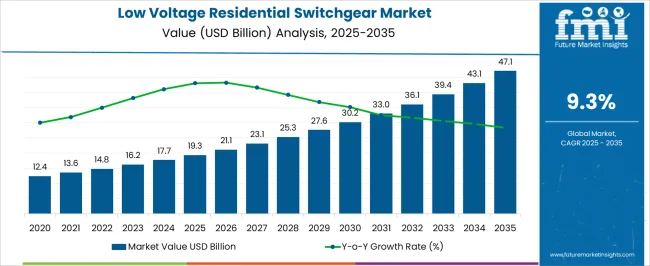
| Metric | Value |
|---|---|
| Low Voltage Residential Switchgear Market Estimated Value in (2025 E) | USD 19.3 billion |
| Low Voltage Residential Switchgear Market Forecast Value in (2035 F) | USD 47.1 billion |
| Forecast CAGR (2025 to 2035) | 9.3% |
The low voltage residential switchgear market is estimated to hold a notable proportion within its parent markets, representing approximately 5-7% of the electrical switchgear market, around 8-9% of the residential electrical systems market, close to 12-14% of the power distribution equipment market, about 3-4% of the electrical components market, and roughly 2-3% of the smart home technology market. Collectively, the cumulative share across these parent segments is observed in the range of 30-37%, highlighting the integral role low voltage residential switchgear plays in residential power distribution and control systems. The market has been driven by the increasing demand for safe, efficient, and cost-effective electrical solutions for homes, where reliability, energy management, and integration with smart systems are prioritized.
Adoption is driven by procurement decisions focusing on safety features, ease of installation, and long-term operational stability. Market participants have focused on improving the design and functionality of low voltage residential switchgear, making it more adaptable to modern home electrical needs, including energy-efficient solutions and automation capabilities. As a result, the low voltage residential switchgear market has not only captured a significant share within residential electrical systems and power distribution equipment markets but has also influenced electrical components and smart home technology markets, underscoring its vital role in enhancing home electrical systems, safety, and overall user experience.
The low voltage residential switchgear market is witnessing strong growth, driven by rising investments in residential infrastructure development and increasing awareness of electrical safety and energy efficiency. Demand is being accelerated by rapid urbanization, especially in emerging economies, which is leading to increased housing construction and renovation activities. The integration of smart home technologies and energy management systems has also contributed to the adoption of advanced low voltage switchgear that supports remote monitoring, control, and automation.
Innovations in compact modular switchgear designs are enhancing convenience, performance, and space efficiency, making them highly suitable for modern residential layouts. Regulatory mandates focused on fire safety, power reliability, and fault protection are encouraging the use of certified low voltage components in residential settings.
Additionally, the push for energy conservation and distributed energy resources such as rooftop solar installations is promoting the deployment of flexible and intelligent switchgear systems With rising demand for durable, smart, and safe electrical infrastructure in households, the market is poised for sustained expansion in the near and long term.
The low voltage residential switchgear market is segmented by installation, current, and geographic regions. By installation, low voltage residential switchgear market is divided into Indoor and Outdoor. In terms of current, low voltage residential switchgear market is classified into AC and DC. Regionally, the low voltage residential switchgear industry is classified into North America, Latin America, Western Europe, Eastern Europe, Balkan & Baltic Countries, Russia & Belarus, Central Asia, East Asia, South Asia & Pacific, and the Middle East & Africa.
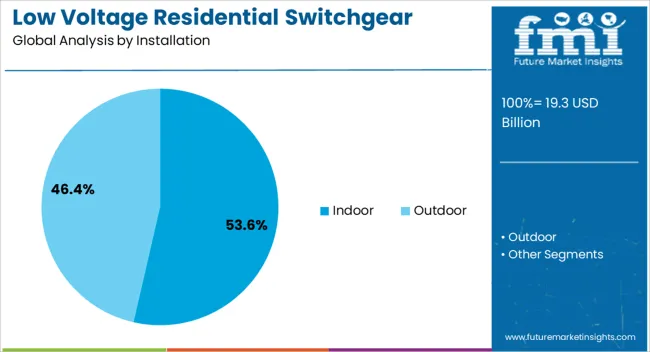
The indoor installation segment is projected to hold 53.6% of the low voltage residential switchgear market revenue share in 2025, establishing it as the leading installation type. This dominance is being supported by the increasing prevalence of indoor electrical panels and load centers in modern residential construction. Indoor switchgear installations are preferred due to ease of access, enhanced protection from environmental factors, and simplified maintenance procedures.
As homes become more compact and energy efficient, the use of concealed and space-saving electrical systems has grown, further reinforcing the demand for indoor installations. Builders and electrical planners are favoring indoor systems for their compatibility with smart metering and home automation solutions, which require centralized and protected electrical distribution points.
Additionally, regulatory trends promoting safer in-home power distribution have led to widespread adoption of indoor low voltage switchgear that meets national and international safety standards. With rising consumer emphasis on aesthetics, safety, and energy control, indoor installations are expected to remain the most widely adopted configuration in residential electrical systems.
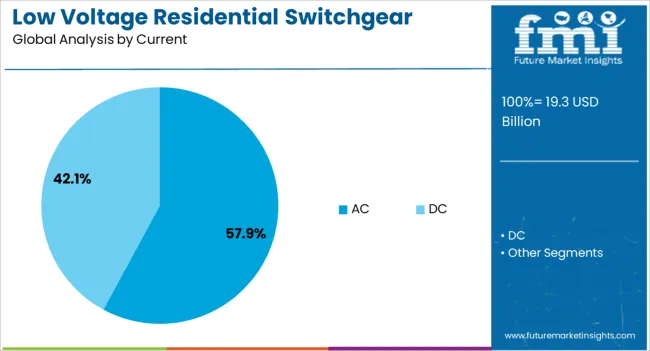
The alternating current segment is expected to account for 57.9% of the low voltage residential switchgear market revenue share in 2025, positioning it as the dominant current type. This leadership is attributed to the widespread use of AC power in residential buildings around the world due to its efficiency in long-distance power transmission and compatibility with the majority of home appliances and systems.
AC switchgear enables safer and more reliable power control, disconnection, and distribution within residential circuits, supporting consistent voltage levels and minimizing the risk of overload or fire hazards. Its compatibility with renewable energy inputs, such as photovoltaic inverters, is further contributing to its dominance, particularly in homes integrating solar power systems.
Manufacturers are continuing to innovate in AC switchgear designs with advanced arc fault detection, surge protection, and real-time monitoring capabilities, improving both safety and convenience. With AC remaining the standard for grid-connected residential electricity supply globally, this segment is expected to maintain its strong growth trajectory through continued demand for efficient and secure home power systems.
The low voltage residential switchgear market is expanding, driven by increasing demand for safer and more reliable home electrical systems. Opportunities in residential renovation projects and the trend towards compact, smart switchgear solutions present significant growth potential. However, price sensitivity and competition from low-cost manufacturers remain challenges that may impact the market. Navigating these challenges while capitalizing on emerging trends will be crucial for players in the market.
The low voltage residential switchgear market is experiencing heightened demand due to the increasing focus on home electrical safety. As homeowners and builders prioritize reliable, safe electrical systems, the demand for low voltage switchgear has surged. These systems help protect residential properties from electrical hazards like short circuits and overloads, making them a critical component in modern electrical installations. As awareness about safety increases and construction activities grow, this market is expected to continue expanding, driven by the need for enhanced electrical protection in homes.
There is significant potential in the residential renovation market for low voltage residential switchgear. As homeowners invest in upgrading and modernizing their electrical systems, the need for state-of-the-art switchgear solutions grows. Older homes, in particular, require retrofitting with modern safety features to comply with new building codes. This creates opportunities for manufacturers to cater to the renovation and retrofitting segment, which is poised for growth. With increasing disposable income, home renovation projects are expected to fuel demand for updated switchgear products.
A key trend in the low voltage residential switchgear market is the increasing adoption of compact and smart switchgear systems. These devices offer enhanced functionality, including remote monitoring and control, while taking up less space than traditional models. With the rise of smart homes, where devices are interconnected for automation and energy management, the demand for smart and space-saving switchgear is growing. This trend reflects a broader shift towards more integrated and efficient home electrical systems, providing significant opportunities for innovative product development.
Despite the growth potential, the low voltage residential switchgear market faces challenges related to price sensitivity and intense competition. Consumers are often focused on affordability, which may limit the adoption of higher-end products with advanced features. Additionally, competition from low-cost manufacturers, particularly in emerging markets, is increasing. As a result, established players must continuously improve their products while offering competitive pricing to maintain market share. Overcoming these challenges will be critical to securing a sustainable position in the market.
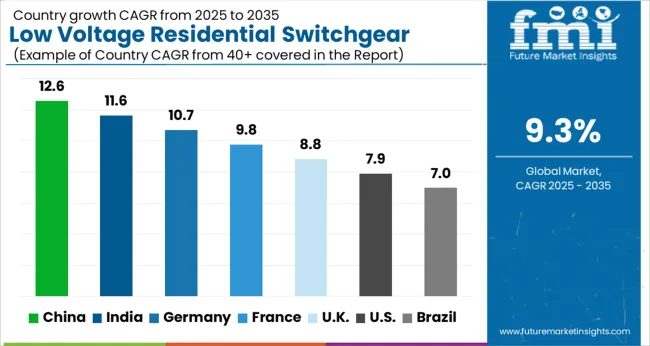
| Country | CAGR |
|---|---|
| China | 12.6% |
| India | 11.6% |
| Germany | 10.7% |
| France | 9.8% |
| UK | 8.8% |
| USA | 7.9% |
| Brazil | 7.0% |
The global low voltage residential switchgear market is projected to grow at a CAGR of 9.3% from 2025 to 2035. China leads with a growth rate of 12.6%, followed by India at 11.6%, and Germany at 10.7%. The United Kingdom records a growth rate of 8.8%, while the United States shows the slowest growth at 7.9%. The market's expansion is driven by the increasing demand for energy-efficient, safe, and reliable electrical systems in residential buildings. Emerging economies like China and India are experiencing rapid urbanization and electrification, while developed economies such as the USA and the UK are focused on upgrading residential infrastructure and integrating smart home solutions. This report includes insights on 40+ countries; the top markets are shown here for reference.
Top Low Voltage Substation Market Dynamics
The low voltage residential switchgear market in China is growing at a rate of 12.6%, driven by the country’s rapid urbanization and expansion of its residential infrastructure. With an increasing population and demand for residential electricity, China is heavily investing in power distribution systems, driving the demand for low voltage switchgear. The Chinese government’s initiatives to improve electricity access and safety standards in urban and rural areas are also contributing to market growth. Furthermore, the integration of smart grid technologies in China is fostering the adoption of advanced switchgear systems. The transition toward sustainable and energy-efficient residential buildings is expected to further increase the demand for low voltage switchgear solutions in the coming years.
The low voltage residential switchgear market in India is growing at a rate of 11.6%, fueled by increasing residential electrification and infrastructure development. India’s expanding urban population is creating a higher demand for reliable and efficient electrical systems, particularly in newly built homes and urban areas. The government’s push for smart city initiatives and residential electrification in rural areas is further accelerating the adoption of low voltage switchgear. Additionally, India’s focus on safety standards and energy efficiency is driving the demand for advanced electrical solutions in residential buildings. The rise in renewable energy adoption, particularly solar power, is also influencing the market as homes increasingly require advanced switchgear systems to manage distributed energy generation.
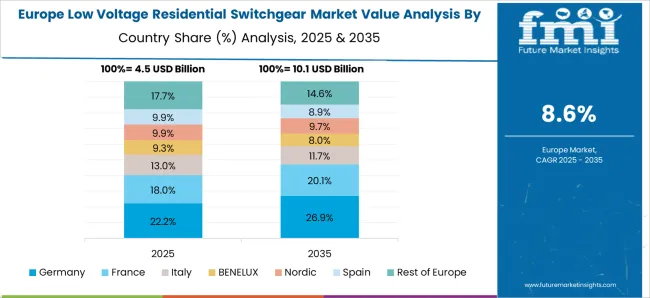
The low voltage residential switchgear market in Germany is growing at a rate of 10.7%, supported by the country’s focus on energy efficiency, building safety, and smart home integration. Germany has long been a leader in adopting energy-efficient technologies, and its residential sector is no exception. The German market is seeing increasing demand for innovative and automated switchgear solutions that offer enhanced safety features and remote control capabilities. The country’s commitment to the energy transition and the integration of renewable energy sources into residential homes is further pushing the need for low voltage switchgear. Germany’s well-established manufacturing and infrastructure sectors are also contributing to the demand for high-quality switchgear solutions in residential buildings.
The low voltage residential switchgear market in the United Kingdom is growing at a rate of 8.8%, with increasing demand driven by the expansion of residential infrastructure and the adoption of smart home technologies. The UK is experiencing a shift toward sustainable living and energy efficiency in residential buildings, and low voltage switchgear plays a critical role in this transition. As the demand for home automation systems and renewable energy solutions rises, there is a greater need for advanced switchgear systems that provide enhanced control, safety, and efficiency. The UK government’s commitment to reducing carbon emissions is also encouraging the installation of energy-efficient electrical systems in residential homes, further driving the market’s growth.
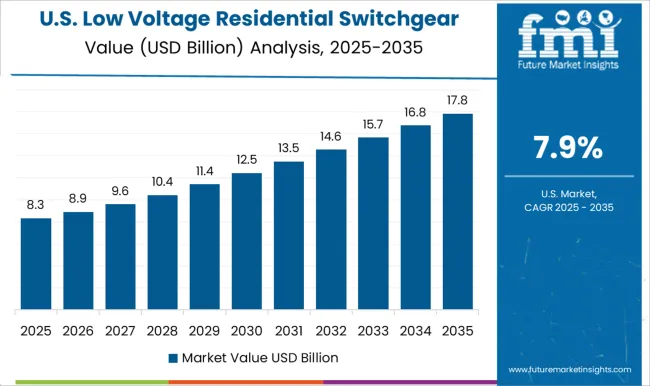
The low voltage residential switchgear market in the United States is growing at a rate of 7.9%, driven by the need for enhanced electrical systems in new and retrofitted residential buildings. The USA residential sector is increasingly adopting smart technologies, which require advanced switchgear for automation and control. Additionally, the USA government’s focus on improving energy efficiency and integrating renewable energy systems in homes is further driving market growth. The shift toward electric vehicles (EVs) and home energy storage systems is also influencing the demand for low voltage switchgear to manage energy distribution efficiently. As USA homeowners seek greater control over their energy consumption, the need for reliable, safe, and intelligent switchgear systems is expected to grow.
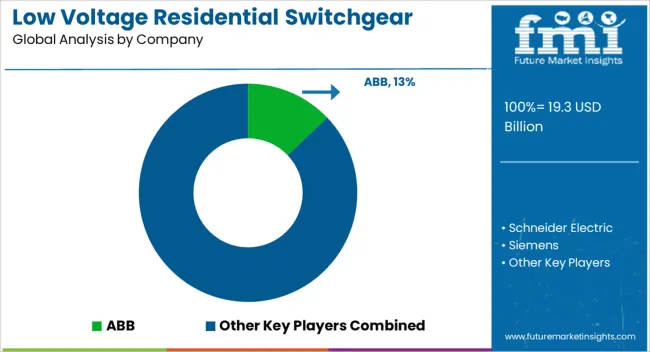
The low voltage residential switchgear market is witnessing significant growth due to the increasing demand for energy-efficient, safe, and reliable electrical systems in residential buildings. Leading companies such as ABB, Schneider Electric, and Siemens are at the forefront of the market, offering innovative switchgear solutions that cater to the rising need for enhanced electrical protection and automation in homes. ABB has a wide range of low voltage products, including circuit breakers and distribution boards, designed to improve residential energy efficiency. Schneider Electric provides comprehensive solutions that offer advanced functionality, such as smart metering and energy management, contributing to greater control over residential energy consumption. Siemens continues to innovate with its eco-friendly switchgear solutions, which not only focus on safety but also address environmental concerns, aligning with the growing trend towards sustainability. In addition to these established players, companies like General Electric, Eaton, and Mitsubishi Electric are also major contributors to the low voltage residential switchgear market.
General Electric offers a range of residential switchgear products designed to optimize power distribution and minimize energy losses. Eaton focuses on providing residential switchgear solutions that meet the demand for energy efficiency, safety, and smart grid compatibility. Mitsubishi Electric brings advanced technologies to residential switchgear, offering products designed for reliable and safe operation in various residential electrical setups. Furthermore, players like CHINT Group, Toshiba, and Fuji Electric are enhancing market competition with their cost-effective and reliable solutions, driving the widespread adoption of low voltage residential switchgear. With ongoing advancements in technology and increasing residential energy needs, this market is poised to grow further as more consumers and builders prioritize electrical safety and efficiency in home constructions.
| Item | Value |
|---|---|
| Quantitative Units | USD 19.3 Billion |
| Installation | Indoor and Outdoor |
| Current | AC and DC |
| Regions Covered | North America, Europe, Asia-Pacific, Latin America, Middle East & Africa |
| Country Covered | United States, Canada, Germany, France, United Kingdom, China, Japan, India, Brazil, South Africa |
| Key Companies Profiled | ABB, Schneider Electric, Siemens, General Electric, Eaton, Mitsubishi Electric, CHINT Group, Toshiba, Hitachi, Fuji Electric, HD Hyundai Electric, Hyosung Heavy Industries, Lucy Group, Ormazabal, CG Power and Industrial Solutions, Skema, and Bharat Heavy Electricals |
| Additional Attributes | Dollar sales by switchgear type (circuit breakers, fuse disconnects, surge protectors) and application (lighting control, power distribution, appliance protection) are key metrics. Trends include rising demand for safety and energy-efficient solutions, growth in residential construction, and increasing adoption of smart home technologies. Regional deployment, regulatory standards, and technological advancements are driving market growth. |
The global low voltage residential switchgear market is estimated to be valued at USD 19.3 billion in 2025.
The market size for the low voltage residential switchgear market is projected to reach USD 47.1 billion by 2035.
The low voltage residential switchgear market is expected to grow at a 9.3% CAGR between 2025 and 2035.
The key product types in low voltage residential switchgear market are indoor and outdoor.
In terms of current, ac segment to command 57.9% share in the low voltage residential switchgear market in 2025.






Full Research Suite comprises of:
Market outlook & trends analysis
Interviews & case studies
Strategic recommendations
Vendor profiles & capabilities analysis
5-year forecasts
8 regions and 60+ country-level data splits
Market segment data splits
12 months of continuous data updates
DELIVERED AS:
PDF EXCEL ONLINE
Low Vibration Thermostat Market Size and Share Forecast Outlook 2025 to 2035
Low-Level Order Picker Pallet Truck Market Size and Share Forecast Outlook 2025 to 2035
Low Temperature Flexible Tester Market Size and Share Forecast Outlook 2025 to 2035
Low Light Imaging Market Forecast Outlook 2025 to 2035
Low Density Polyethylene Market Forecast and Outlook 2025 to 2035
Low-Temperature Cable Market Size and Share Forecast Outlook 2025 to 2035
Low Molecular Weight Chondroitin Sulfate Sodium Market Size and Share Forecast Outlook 2025 to 2035
Low Temperature Radiators Market Size and Share Forecast Outlook 2025 to 2035
Low Rolling Resistance Tire Market Size and Share Forecast Outlook 2025 to 2035
Low Temperature Commercial Boiler Market Size and Share Forecast Outlook 2025 to 2035
Low Emissivity Film Market Size and Share Forecast Outlook 2025 to 2035
Low Migration Inks Market Size and Share Forecast Outlook 2025 to 2035
Low Density Polyethylene Packaging Market Size and Share Forecast Outlook 2025 to 2035
Low Temperature Insulation Materials Market Size and Share Forecast Outlook 2025 to 2035
Low Clearance Loaders Market Size and Share Forecast Outlook 2025 to 2035
Low Calorie Desserts Market Size and Share Forecast Outlook 2025 to 2035
Low-Grade Glioma Therapeutics Market Size and Share Forecast Outlook 2025 to 2035
Low Power Wide Area Network (LPWAN) Market Size and Share Forecast Outlook 2025 to 2035
Low Fat Drinks Market Size and Share Forecast Outlook 2025 to 2035
Low Fat Content Kefir Market Size and Share Forecast Outlook 2025 to 2035

Thank you!
You will receive an email from our Business Development Manager. Please be sure to check your SPAM/JUNK folder too.
Chat With
MaRIA